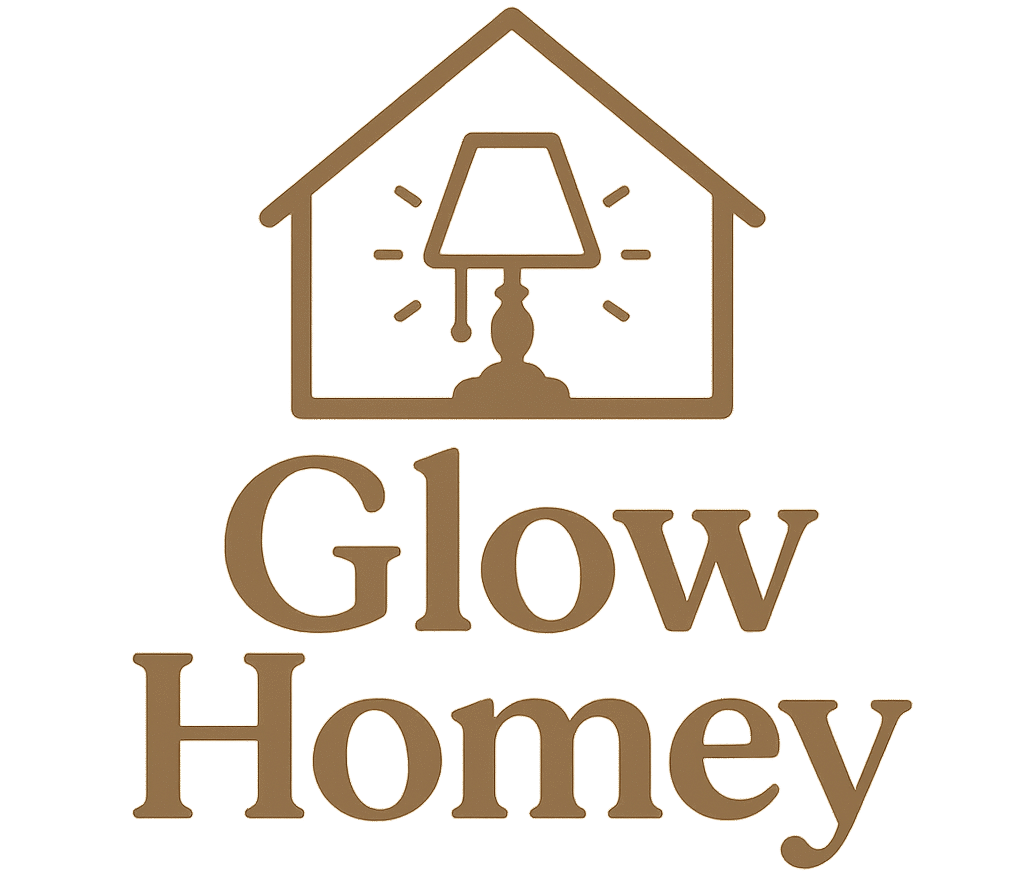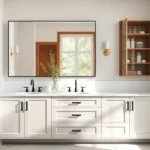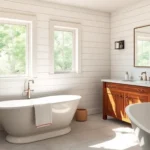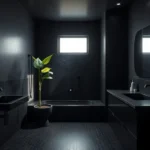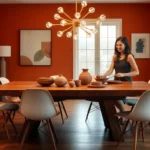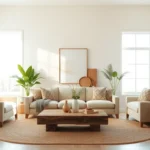Small bathrooms don’t have to feel cramped or uninspiring. We’ve discovered that the right paint choices can completely transform these compact spaces into stunning retreats that feel bigger brighter and more luxurious than you’d ever imagine possible.
Whether you’re dealing with a powder room that’s barely big enough to turn around in or a full bath that feels more like a closet we know exactly which painting techniques and color strategies will maximize your space. From clever visual tricks that make walls appear to recede to bold statement colors that create dramatic focal points the possibilities are endless.
We’re about to share our favorite paint ideas that’ll help you turn your small bathroom into a design masterpiece. These proven techniques have transformed countless tiny spaces and we’re confident they’ll work wonders in your home too.
Choose Light Colors to Create the Illusion of Space
Light colors reflect more natural light and create visual depth, making your small bathroom feel significantly larger than its actual square footage.
Use White and Off-White Shades
White paint remains our top recommendation for maximizing space in compact bathrooms. Pure white reflects up to 80% of available light, instantly brightening even the darkest powder rooms. We’ve seen dramatic transformations using classic whites like Benjamin Moore’s Cloud White or Sherwin Williams’ Pure White on all four walls.
Off-white shades provide warmth while maintaining the spacious feel. Colors like Swiss Coffee or Ivory create a softer alternative to stark white without sacrificing the room-expanding benefits. These subtle tones work particularly well in bathrooms with limited natural light, as they prevent the space from feeling cold or clinical.
Pairing white walls with white trim creates seamless visual flow. This monochromatic approach eliminates visual breaks that can make small spaces feel choppy. We recommend using the same white shade on walls, ceiling, and trim for maximum impact.
Consider Soft Pastels Like Powder Blue or Mint Green
Powder blue creates a spa-like atmosphere while maintaining the illusion of space. This gentle hue reflects light beautifully and pairs perfectly with white fixtures and chrome finishes. We’ve found that powder blue works exceptionally well in bathrooms with good natural light, as it enhances the airy feeling.
Mint green offers a fresh, organic feel that opens up cramped quarters. This soft pastel connects your bathroom to nature while keeping the space feeling bright and uncluttered. Mint green complements both modern and traditional design elements, making it versatile for various decorating styles.
Lavender provides a sophisticated alternative to traditional bathroom colors. This subtle purple tone creates depth without overwhelming the space, and it pairs beautifully with white or silver accents. We recommend testing lavender in different lighting conditions, as it can appear more purple or gray depending on your bathroom’s exposure.
Opt for Warm Neutrals Like Cream or Beige
Cream paint creates cozy warmth while preserving the spacious feeling. This versatile neutral works with both cool and warm lighting, making it ideal for bathrooms that serve multiple family members. We often recommend cream for guest bathrooms where you want to create a welcoming yet sophisticated atmosphere.
Beige offers earthy sophistication that never goes out of style. Modern beige shades like greige (gray-beige) provide contemporary appeal while maintaining the light-reflecting properties essential for small spaces. These colors create an elegant backdrop for colorful towels and accessories.
Warm grays bridge the gap between stark white and traditional beige. Colors like Accessible Beige or Classic Gray provide enough warmth to feel inviting while remaining light enough to maximize your bathroom’s perceived size. These versatile neutrals complement both traditional and contemporary fixtures seamlessly.
Select Bold Accent Colors for Visual Interest
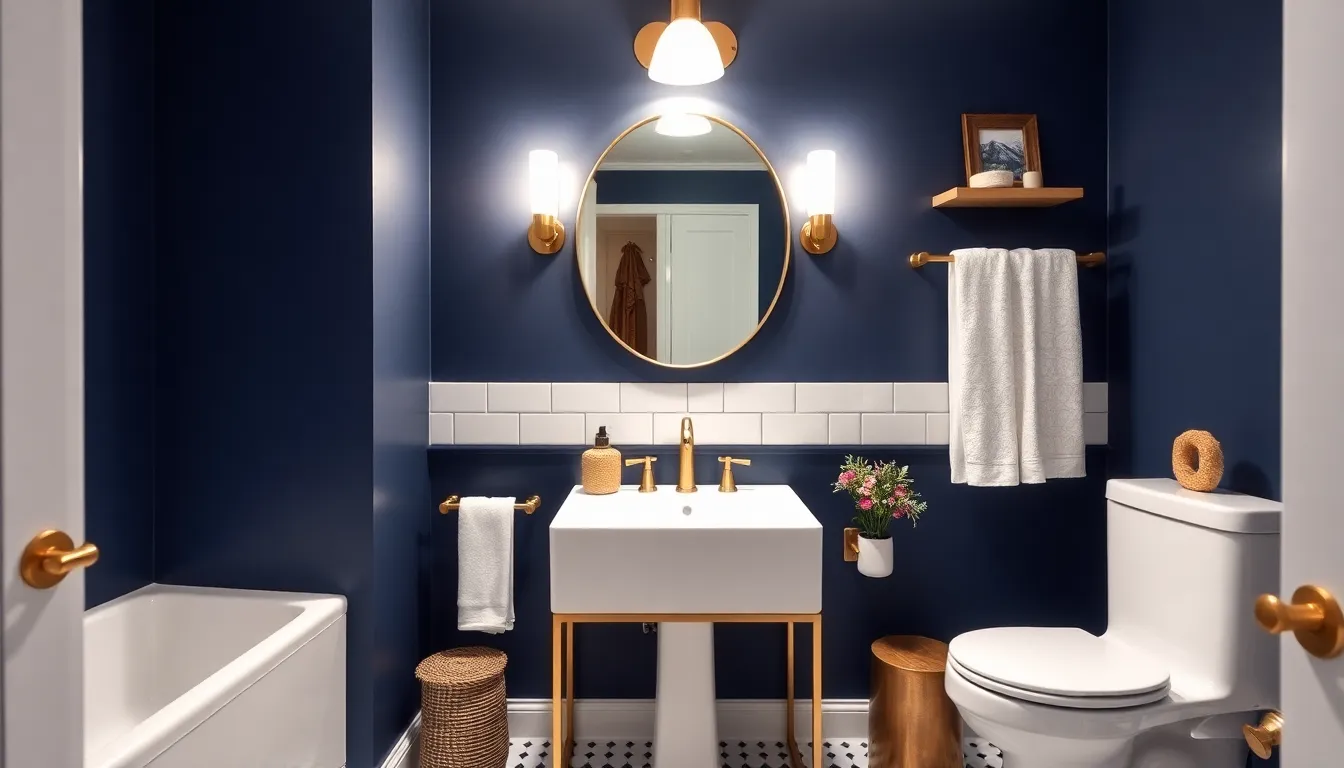
While light colors expand small bathroom spaces, strategic bold accents can add personality without overwhelming the room. We’ve found that incorporating one dramatic color creates stunning focal points that actually enhance the perception of space.
Paint One Feature Wall in a Deep Navy or Forest Green
Deep navy blue transforms small bathrooms by adding sophisticated depth that makes walls appear to recede. We recommend painting the wall behind the vanity or opposite the entrance to create maximum visual impact. This rich color works exceptionally well when paired with white fixtures and bright lighting.
Forest green offers another compelling option for feature walls in compact bathrooms. Combining this earthy tone with brass fixtures and warm wood accents creates a timeless aesthetic that feels both cozy and expansive. We’ve seen this combination work beautifully in powder rooms where the rich green backdrop makes white porcelain fixtures pop.
Add Personality with a Vibrant Coral or Emerald Accent
Vibrant coral brings warmth and energy to small bathroom spaces without making them feel cramped. We suggest using this lively hue on a single accent wall or in tile backsplashes where it can energize the entire room. Coral pairs beautifully with crisp white trim and neutral flooring for a balanced look.
Emerald accents create jewel toned sophistication that elevates any small bathroom design. This rich green works particularly well when applied to lower wainscoting or as an unexpected ceiling color. We’ve found that emerald creates stunning contrast against white subway tiles and chrome fixtures.
Create Drama with Black or Charcoal Gray
Matte black walls can make small bathrooms feel surprisingly spacious when executed properly. We recommend painting both walls and ceilings in black for an enveloping cocoon effect that eliminates visual boundaries. This bold approach works best with abundant lighting and white or metallic accents to prevent the space from feeling cave like.
Charcoal gray offers a softer alternative to pure black while still delivering dramatic impact. This versatile shade creates sophisticated contrast when paired with white wainscoting or bright accent colors. We’ve successfully used charcoal as a backdrop for colorful artwork and vibrant towels in many small bathroom projects.
Apply Vertical Stripes to Maximize Height
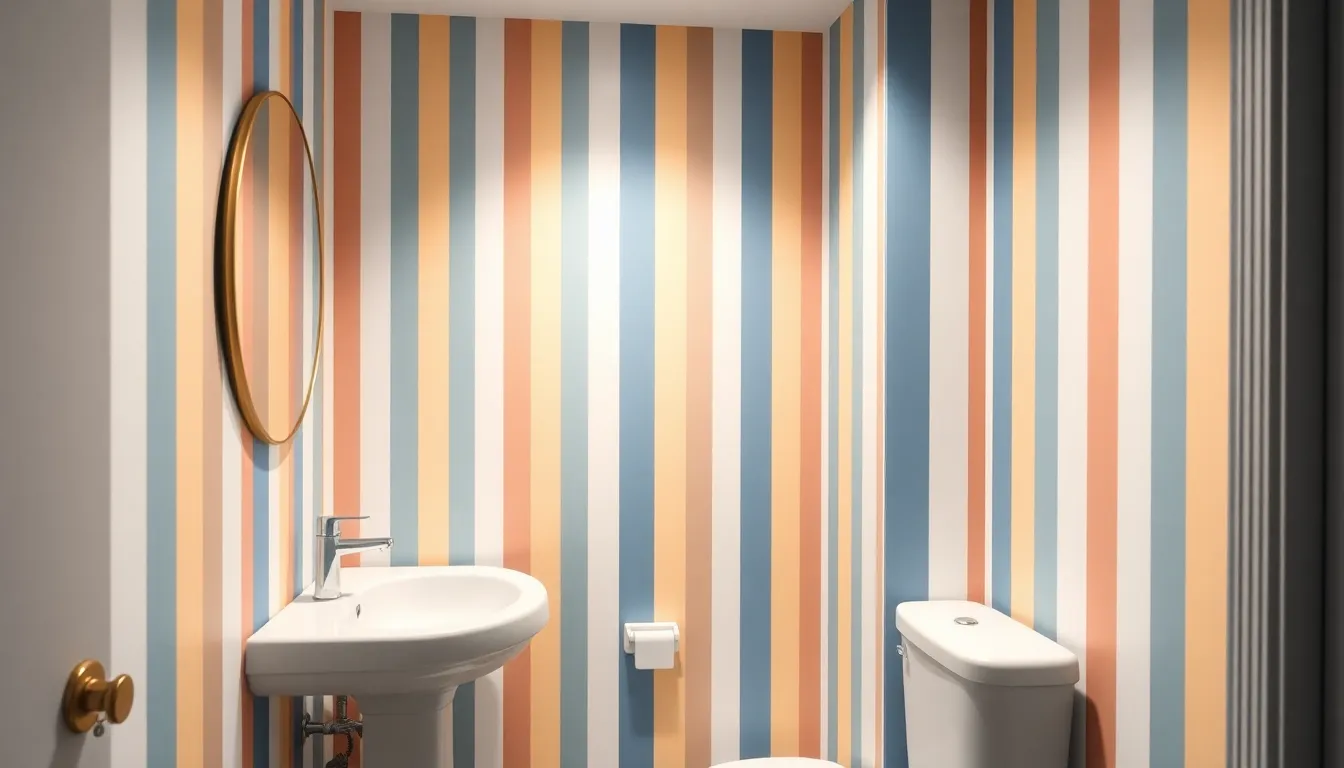
Vertical stripes work like magic in small bathrooms by creating the illusion of taller walls and expanded space. We’ve seen this technique transform countless compact bathrooms into rooms that feel significantly more open and airy.
Use Painter’s Tape for Clean, Professional Lines
Painter’s tape is essential for achieving those crisp, professional stripe lines that make all the difference in your bathroom’s final appearance. We always start by measuring and marking our stripe placement with a pencil before applying the tape. Press down firmly along the tape edges to prevent paint bleeding underneath and creating uneven lines. Remove the tape while the paint is still slightly wet for the cleanest results and sharpest stripe definition.
Alternate Between Two Complementary Colors
Two complementary colors create stunning visual interest while maintaining the height improving effect of vertical stripes. We recommend pairing classic white with soft gray for a timeless look that brightens the space. Navy and cream combinations offer sophisticated contrast without overwhelming small bathroom dimensions. Teal and white stripes bring a spa like feeling that’s both calming and energizing. Choose colors with similar saturation levels to ensure your stripes work harmoniously together rather than competing for attention.
Keep Stripes Narrow for a Subtle Effect
Narrow stripes are recommended to avoid overwhelming small spaces while still achieving the desired height enhancement. We suggest keeping stripe widths between 2 to 4 inches for the most effective visual impact in compact bathrooms. Wider stripes can make small rooms feel cramped and busy rather than expanded. Consistent stripe spacing creates rhythm and flow that guides the eye upward naturally. Measure carefully and maintain uniform stripe widths throughout your bathroom for a polished, professional appearance that maximizes your space’s potential.
Incorporate High-Gloss or Semi-Gloss Finishes
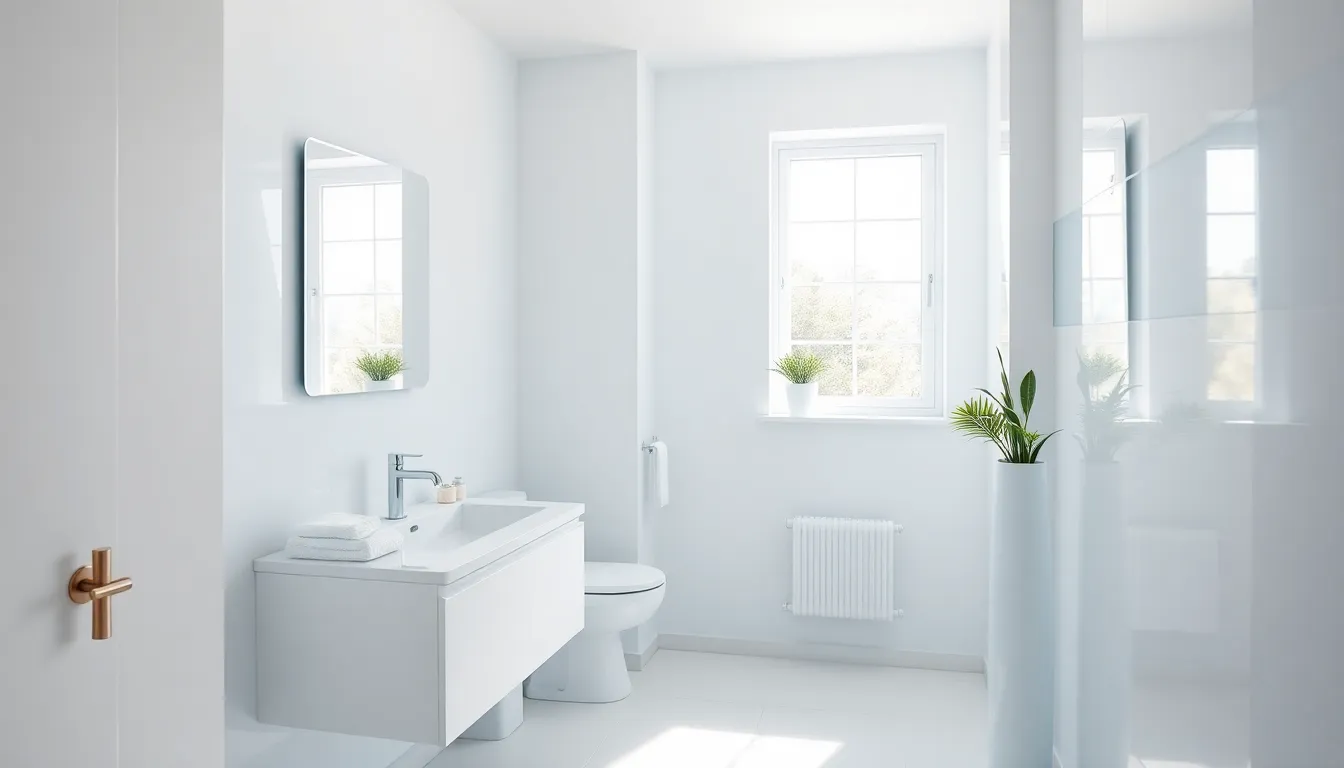
High-gloss and semi-gloss finishes offer the perfect solution for small bathroom painting projects. These finishes excel at reflecting light while providing superior durability in moisture-rich environments.
Choose Moisture-Resistant Paint Formulas
Moisture-resistant paint formulas specifically designed for bathrooms should be your top priority when selecting finishes. These specialized paints withstand humidity and steam without peeling or flaking, ensuring your small bathroom walls maintain their fresh appearance for years.
High-gloss finishes provide maximum moisture resistance due to their dense, non-porous surface that repels water effectively. Semi-gloss options offer excellent moisture protection while being more forgiving of wall imperfections than their high-gloss counterparts.
Bathroom-exact paint formulations contain additives that prevent mold and mildew growth, protecting both your walls and your family’s health. We recommend investing in quality moisture-resistant paints rather than standard interior paints, as the long-term benefits far outweigh the initial cost difference.
Create Easy-to-Clean Surfaces
Easy-to-clean surfaces become essential in small bathrooms where every inch matters and maintenance convenience is crucial. High-gloss finishes excel at creating wipeable surfaces that resist stains and allow for effortless cleaning with just a damp cloth.
Semi-gloss finishes balance durability with practicality, offering surfaces that clean easily without showing every fingerprint or water spot. These finishes handle regular scrubbing without losing their luster, making them ideal for busy family bathrooms.
Surface preparation plays a crucial role in achieving smooth, easy-to-clean walls that resist dirt accumulation. We always recommend filling holes, sanding rough spots, and priming properly before applying your chosen finish to ensure optimal cleanability.
Light colors in high-gloss or semi-gloss finishes show dirt less readily than darker shades, making maintenance even simpler in your small bathroom space.
Enhance Light Reflection Throughout the Space
Light reflection enhancement becomes dramatically more effective when you choose high-gloss finishes for your small bathroom walls. These finishes act like mirrors, bouncing available light around the room and creating the illusion of expanded space.
High-gloss paints reflect up to 80% of light that hits them, making your small bathroom appear significantly larger and brighter. Semi-gloss finishes reflect approximately 60% of light while providing a more subtle sheen that works well with various lighting conditions.
Strategic placement of high-gloss finishes on walls opposite windows or light sources maximizes natural light distribution throughout your space. We often recommend using high-gloss on the wall behind the vanity mirror to create a double reflection effect that amplifies both natural and artificial lighting.
Bright white or pale blue walls in high-gloss finishes deliver the most dramatic light reflection results, transforming even the smallest bathroom into a luminous, spacious-feeling retreat.
Paint the Ceiling to Draw the Eye Upward
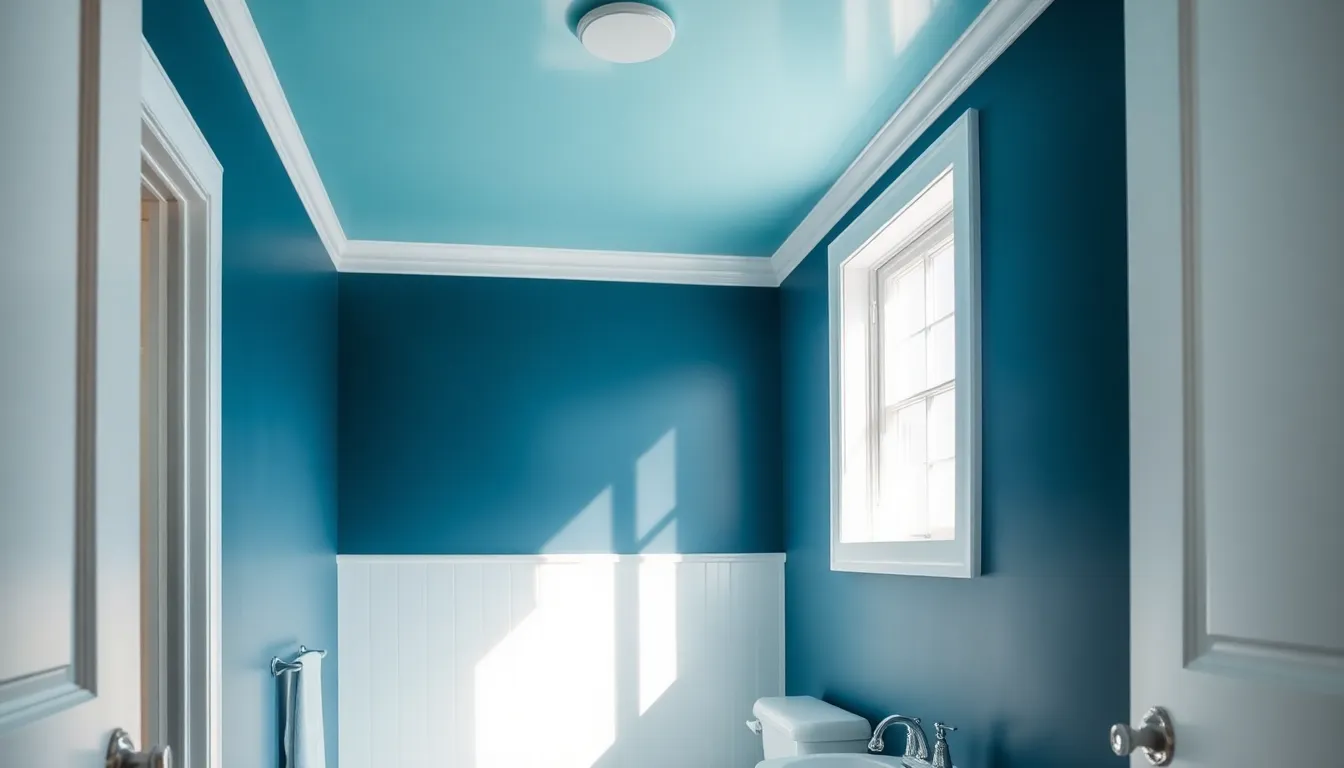
Transforming your small bathroom’s ceiling into a visual focal point can dramatically enhance the room’s perceived height and spaciousness. This technique breaks traditional visual boundaries and creates an upward flow that makes the space feel larger.
Use a Lighter Shade Than the Walls
Lighter ceiling shades create an immediate illusion of height while maximizing light reflection throughout your bathroom. We recommend choosing a shade that’s 2-3 tones lighter than your wall color to achieve optimal contrast without jarring transitions.
Soft whites work exceptionally well for this approach, particularly Benjamin Moore’s Cloud White or similar pale neutrals that complement darker wall treatments. These lighter tones reflect both natural and artificial light more effectively, contributing to a brighter overall atmosphere.
Cream and pale ivory shades offer warmth while maintaining the space improving benefits of lighter colors. When paired with deeper wall colors like navy or forest green, these ceiling treatments create stunning depth and visual interest.
Try a Soft Sky Blue for an Airy Feel
Soft sky blue mimics the openness of a clear sky, making it one of our most effective color choices for small bathroom ceilings. This color naturally draws the eye upward while creating a tranquil, spa like environment that feels infinitely more spacious.
Benjamin Moore’s Breath of Fresh Air or similar pale blue tones work beautifully with white or cream walls. The psychological effect of sky blue creates an immediate sense of openness that transforms even the tiniest powder room into an airy retreat.
Pairing sky blue ceilings with white trim and fixtures enhances the outdoor feeling while maintaining a clean, cohesive look. This combination works particularly well in bathrooms with limited natural light, as the blue tone compensates for the lack of sky views.
Consider Matching the Ceiling to the Walls
Matching your ceiling color to your walls creates a seamless, cocoon like effect that visually dissolves boundaries between surfaces. This technique works especially well with lighter or neutral tones that won’t overwhelm the limited square footage.
Monochromatic schemes using soft grays, warm whites, or pale pastels eliminate visual stopping points that can make small spaces feel choppy. We’ve seen remarkable results with this approach in bathrooms painted entirely in Swiss Coffee or similar warm neutrals.
Contrasting trim becomes crucial when using this technique, as white or cream molding helps define the space while maintaining the expansive feeling. The key lies in choosing colors light enough to reflect adequate light while creating the desired cohesive atmosphere.
Add Geometric Patterns for Modern Appeal
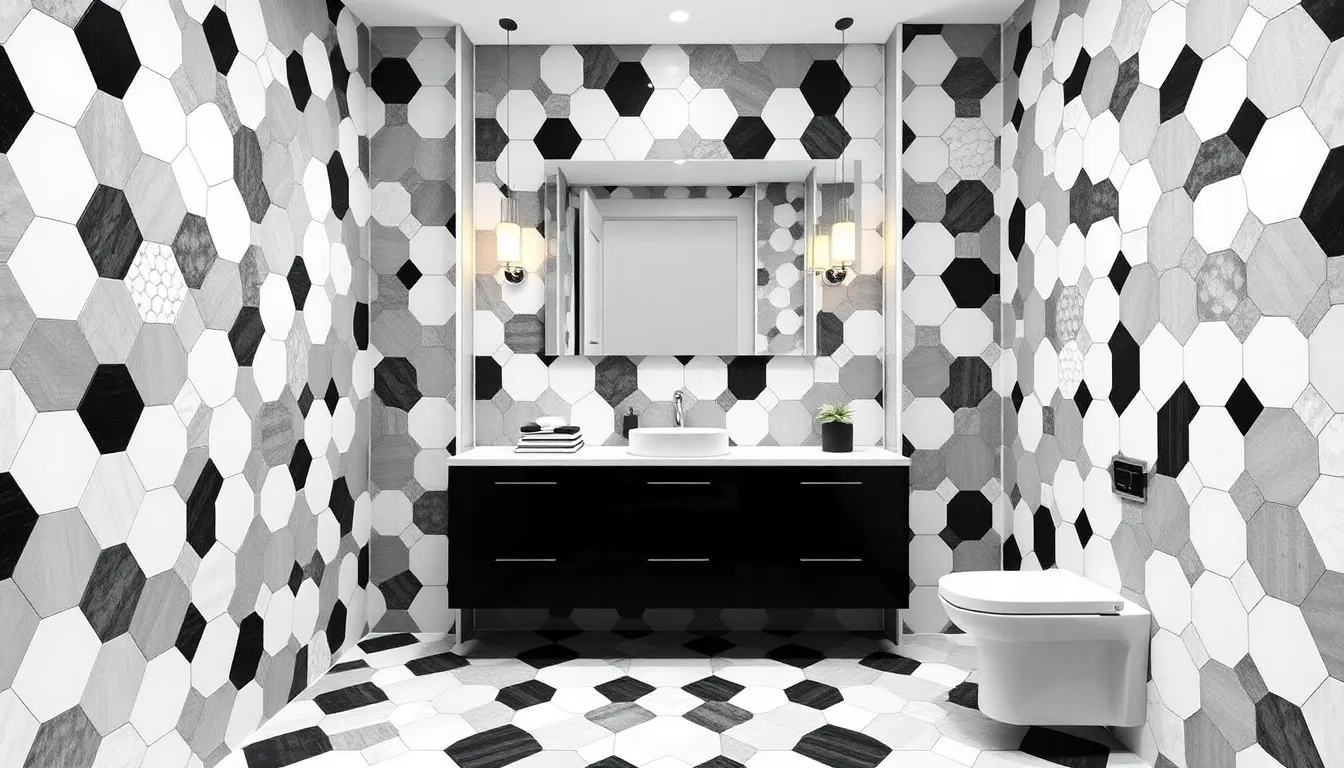
Transform your small bathroom with geometric patterns that instantly create contemporary style and visual depth. We’ve found that shapes like squares, triangles, and rhombuses can make compact spaces feel larger while adding sophisticated design elements.
Create Hexagonal or Diamond Shapes
Hexagonal patterns bring exceptional versatility to small bathroom walls and floors. We recommend arranging hexagonal tiles in herringbone configurations to maximize character and create the illusion of expanded space. Diamond shapes work particularly well as accent features, drawing the eye upward to enhance perceived height. Consider using rhombus mosaic tiles for their proven ability to create various geometric arrangements that suit both traditional and modern aesthetics. Position these patterns strategically on feature walls or shower surrounds to create stunning focal points without overwhelming the limited square footage.
Use Stencils for Precise Pattern Application
Stencils deliver professional results when creating intricate geometric designs in small bathrooms. We’ve discovered that this technique ensures clean, sharp lines essential for hexagonal and diamond patterns. Apply painter’s tape around stencil edges to prevent paint bleeding and achieve crisp geometric boundaries. Work with small sections at a time to maintain precision, especially when creating complex patterns like interlocking hexagons. Remove stencils while paint remains slightly wet to avoid peeling and ensure smooth pattern edges that enhance the overall modern appeal.
Keep Color Combinations Simple and Cohesive
Monochromatic schemes work exceptionally well for geometric patterns in small bathrooms. We suggest using black and white combinations for their versatility and timeless appeal that pairs beautifully with various accent colors. Complementary color palettes prevent visual overwhelm while maintaining the sophisticated look geometric patterns provide. Limit your palette to two or three colors maximum to preserve the clean, modern aesthetic. Consider soft grays with white for subtle geometric interest, or navy with cream for patterns that add depth without compromising the spacious feeling we’ve established with your base paint choices.
Use Color Blocking Techniques
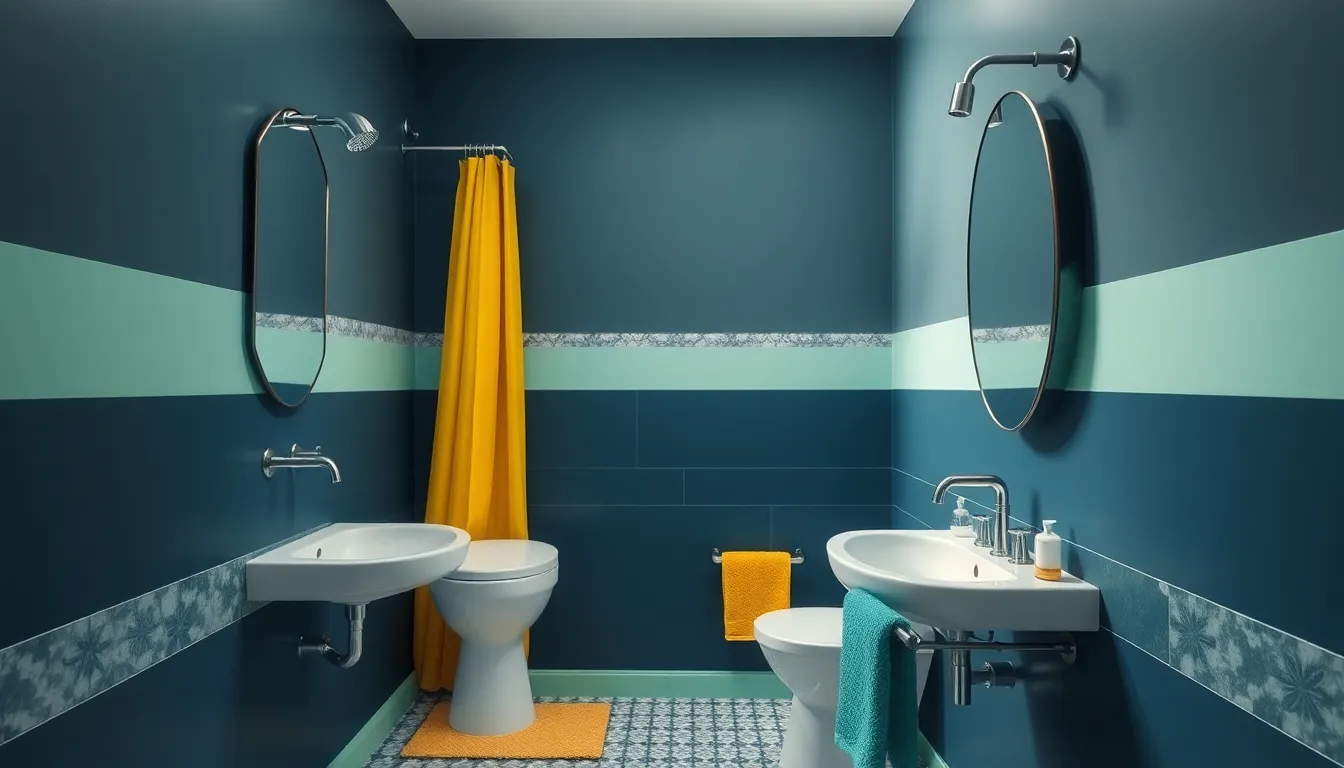
Color blocking transforms small bathrooms into ever-changing, visually captivating spaces that feel larger and more sophisticated. We’ll explore strategic approaches that create depth and interest while maximizing your bathroom’s potential.
Divide Walls Into Distinct Color Sections
Vertical color blocks make ceilings appear higher by drawing the eye upward through contrasting paint sections. We recommend pairing deep navy blue on the bottom half with soft mint green above for a refreshing, spa-like atmosphere that creates visual height.
Material contrasting adds sophisticated depth when we combine different textures like painted walls and decorative tiles in opposing colors. Wallpaper sections paired with solid paint create ever-changing focal points that enhance the room’s architectural features.
Strategic placement works best when we position darker colors on lower wall sections and lighter shades above. This natural weight distribution creates balance while making the space feel more expansive and airy.
Create Horizontal Bands of Different Hues
Color gradients visually widen narrow bathrooms when we paint horizontal bands from light to dark or across complementary hues. Lighter colors positioned on upper wall sections highlight architectural details while making the ceiling feel higher.
Band proportions should range between 2 to 4 inches wide to avoid overwhelming the space while maintaining visual impact. We suggest using painter’s tape to ensure clean, professional lines that create seamless transitions between color sections.
Architectural highlighting becomes more effective when we use contrasting horizontal bands to emphasize molding, wainscoting, or built-in features. This technique draws attention to positive design elements while creating the illusion of expanded width.
Balance Bold and Neutral Tones
Neutral foundations provide the perfect backdrop for bold color accents without overwhelming small bathroom spaces. We recommend using cream, beige, or soft gray as base colors on floors and larger wall areas to create visual cohesion.
Accent strategies work best when we introduce bold colors through smaller elements like painted vanities, colorful accessories, or single feature walls. Bright yellow shower curtains paired with teal towels add energizing pops of color while maintaining spatial balance.
Proportional distribution ensures bold colors don’t dominate by limiting them to 20-30% of the total color scheme. We suggest using vibrant hues on removable elements like bath mats and artwork so you can easily update the look without major renovations.
Apply Ombré or Gradient Effects
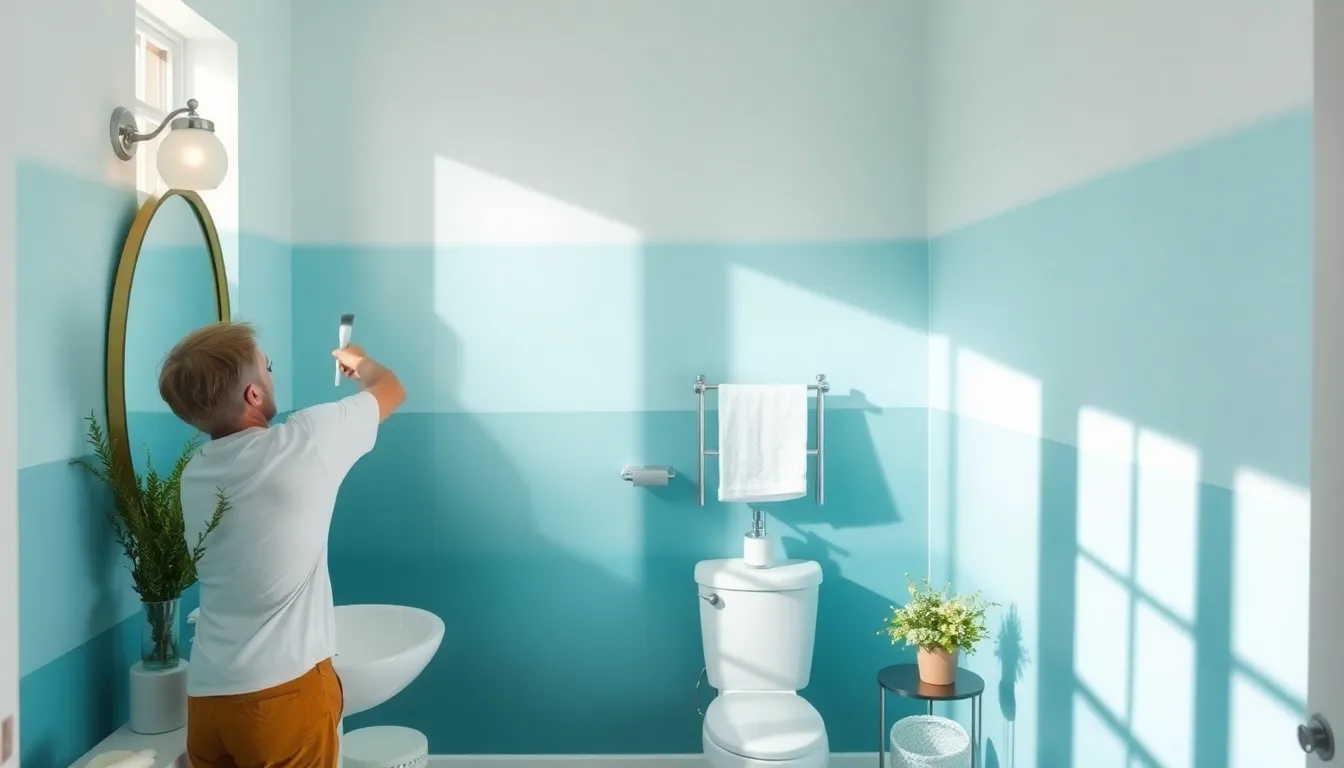
Ombré techniques create stunning visual depth that makes small bathrooms feel dramatically larger and more sophisticated. We’ve seen this gradient approach transform countless compact spaces by adding movement and dimension to otherwise flat walls.
Blend Colors From Light to Dark
Blending colors from light to dark creates the perfect illusion of expanded vertical space in your small bathroom. We recommend starting with your lightest shade at the ceiling line and gradually transitioning to deeper tones as you move toward the floor. This technique draws the eye upward naturally while making walls appear taller than their actual height.
Starting with whites or pale pastels at the top and deepening to mid-tones creates the most effective spatial enhancement. We’ve found that a three-color progression works best for small spaces—begin with a soft white, transition through a medium tone, and finish with a color that’s 2-3 shades deeper. The key lies in maintaining the same color family throughout the gradient to ensure smooth visual flow.
Professional painters typically work in 12-18 inch sections when creating these transitions. We suggest using a large brush or foam roller to blend each section while the paint remains workable. This method ensures seamless color transitions that enhance your bathroom’s perceived dimensions.
Use a Sea Glass or Sunset Color Palette
Sea glass color palettes bring tranquil sophistication to small bathrooms while maximizing the space-improving benefits of ombré techniques. We love using pale aqua tones like Sherwin-Williams Window Pane SW 6210 at the top, blending down through seafoam greens to deeper teal shades. These ocean-inspired hues reflect light beautifully and create a serene atmosphere that makes your bathroom feel like a coastal retreat.
Sunset palettes offer warmth and energy through carefully blended warm tones. Starting with soft cream or pale peach at the ceiling and transitioning through coral to deeper terracotta creates a cozy yet spacious feeling. We’ve seen this combination work particularly well in bathrooms with limited natural light, as the warm colors compensate for darker conditions.
Both palettes work exceptionally well with white fixtures and natural materials. Light taupe accents like Sherwin-Williams Agreeable Gray complement sea glass tones perfectly, while sunset palettes pair beautifully with brass or copper fixtures. These color combinations create sophisticated depth that transforms your small bathroom into a luxurious sanctuary.
Work Quickly While Paint Is Still Wet
Working quickly while paint remains wet ensures smooth, professional-looking gradient transitions that maximize the space-improving effects of ombré techniques. We recommend completing each wall section within 15-20 minutes of initial application to maintain workable paint consistency. This timing allows colors to blend naturally without creating harsh lines or patchy areas.
Temperature and humidity significantly affect your working time with gradient techniques. We’ve learned that cooler temperatures (65-70°F) and moderate humidity levels provide the ideal conditions for blending colors. Higher temperatures cause paint to dry too quickly, making smooth transitions nearly impossible to achieve.
Using a spray bottle with clean water helps extend your working time when blending colors becomes challenging. Light misting keeps the paint surface workable for several additional minutes, allowing you to perfect those seamless transitions. We always keep damp cloths nearby to soften any edges that begin setting before we can blend them properly.
Planning your color sequence before opening any paint containers saves valuable working time. We suggest having all colors mixed and ready, with brushes and blending tools within easy reach. This preparation ensures you can focus entirely on creating those beautiful gradient effects that make your small bathroom appear larger and more elegant.
Paint Built-In Storage and Fixtures
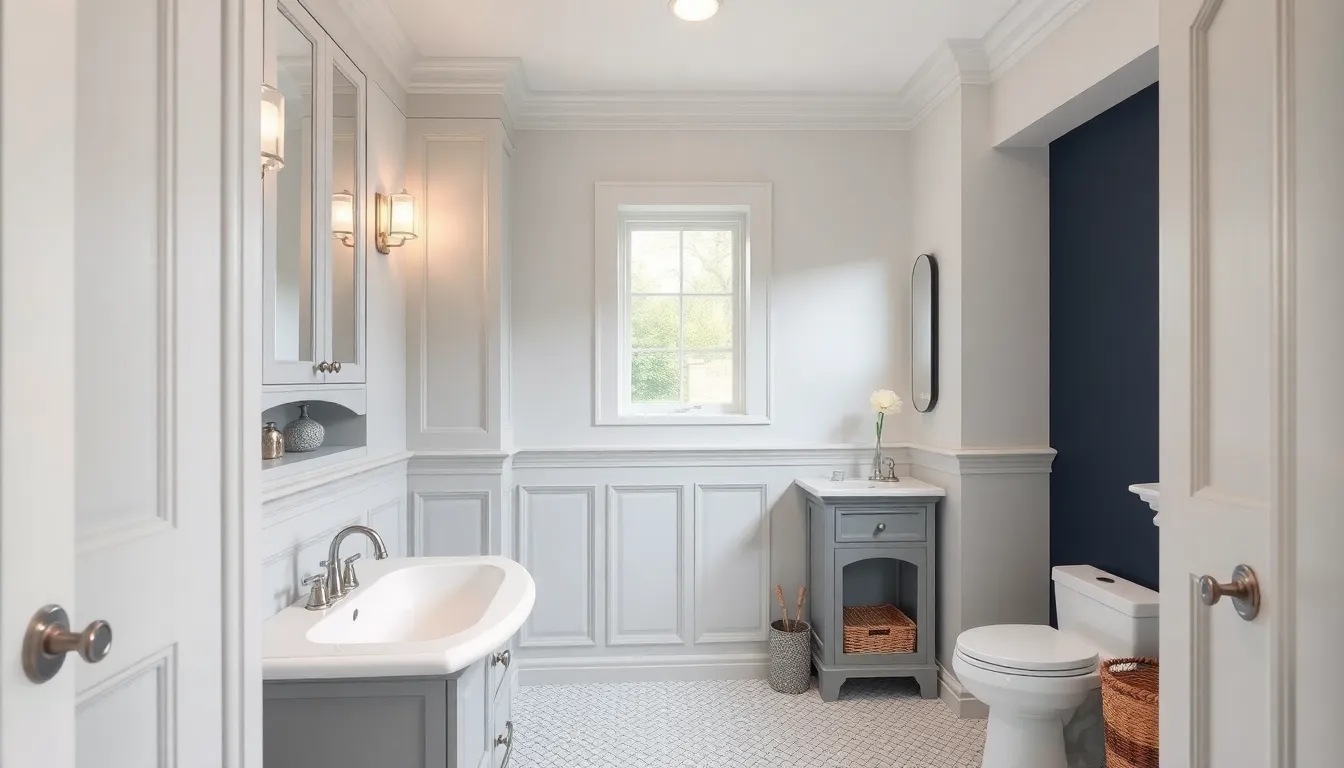
Extending our color palette beyond walls to include built-in elements creates a unified look that maximizes visual space. This comprehensive approach transforms cluttered-looking fixtures into seamless extensions of the room’s design.
Match Vanities and Cabinets to Wall Colors
Painting vanities and cabinets the same color as your walls creates an integrated, spacious feel throughout the bathroom. We recommend using identical or closely related paint shades for cabinetry and walls to establish smooth visual flow and prevent the space from feeling disjointed or cramped. This technique proves especially beneficial in bathrooms with limited natural light, where contrasting cabinet colors might create harsh visual breaks that make the room appear smaller.
Consider painting bathroom cabinets in the same soft gray or warm beige as your walls to achieve maximum cohesion. Built-in medicine cabinets and linen closets benefit from this treatment, virtually disappearing into the wall plane when painted to match. We’ve found that matching vanity bases to wall colors while keeping countertops and hardware as subtle contrasts maintains visual interest without overwhelming the space.
Create Cohesion with Painted Trim and Molding
Painting trim and molding in the same or complementary shades as your main walls enhances overall bathroom cohesion and prevents architectural details from fragmenting the space. We suggest using consistent colors for trim and walls to create smooth visual flow, particularly in compact bathrooms where multiple trim pieces might otherwise feel overwhelming. This approach works exceptionally well in bathrooms featuring wainscoting or crown molding, keeping the overall design streamlined and spacious.
Matching baseboards, door frames, and window trim to wall colors eliminates visual stops that can make small bathrooms feel choppy. We recommend extending this technique to built-in towel racks, toilet paper holders, and decorative molding around mirrors. Painting these elements in wall-matching colors helps them recede visually, allowing the eye to move freely around the room without catching on contrasting details.
Use Contrasting Colors for Visual Pop
Strategic contrast adds ever-changing interest without overpowering small bathroom spaces when applied thoughtfully to select fixtures and accents. We suggest painting exact elements like accent walls, ceilings, or individual fixtures in deeper or brighter colors such as bold navy, forest green, or matte black to create focal points that enhance spatial perception. This technique works particularly well when contrasting elements comprise no more than 20-30% of the total visual space.
Consider painting floating shelves, towel bars, or a statement door in deeper hues while keeping main walls light and airy. We’ve successfully used contrasting cabinet interiors or back panels of open shelving to add depth without overwhelming the room. Pairing these dramatic accents with lighter main surfaces and reflective elements like mirrors ensures the space maintains its open, spacious feeling while gaining personality and visual interest.
Conclusion
Transform your small bathroom from cramped to captivating with these proven paint strategies. We’ve shared techniques that work – from light-improving whites to bold accent walls that create stunning focal points.
Remember that the right finish matters just as much as color choice. High-gloss and semi-gloss paints don’t just look beautiful – they’ll stand up to moisture while reflecting light to make your space feel larger.
Whether you choose calming pastels or dramatic geometric patterns your small bathroom can become a stylish retreat. Start with one technique that speaks to you and watch how the right paint choices can completely transform your space.
Frequently Asked Questions
What are the best paint colors for making a small bathroom look bigger?
Light colors are your best bet for creating the illusion of space. Classic whites like Benjamin Moore’s Cloud White and off-whites such as Swiss Coffee reflect light beautifully and maximize brightness. Soft pastels like powder blue, mint green, and lavender also maintain an airy feel while adding subtle color without overwhelming the space.
Should I use the same color on walls and ceiling in a small bathroom?
You can match walls and ceiling for a seamless look, but using a ceiling color 2-3 tones lighter than your walls is often more effective. This draws the eye upward and creates an illusion of height. Soft whites, pale neutrals, or even soft sky blue work excellently for ceilings in small bathrooms.
What paint finish works best for small bathrooms?
High-gloss and semi-gloss finishes are ideal for small bathrooms because they reflect light and provide excellent moisture resistance. High-gloss offers maximum durability and light reflection, making spaces appear larger and brighter. These finishes are also easy to clean and maintain in humid environments.
Can I use bold colors in a small bathroom without making it feel cramped?
Yes! Use bold colors strategically as accent walls or limit them to 20-30% of your total color scheme. Deep navy, forest green, vibrant coral, or even matte black can create stunning focal points. The key is balancing bold accents with lighter base colors and ensuring adequate lighting.
How do vertical stripes help make small bathrooms look taller?
Vertical stripes create the illusion of height by drawing the eye upward. Use painter’s tape to create clean lines and alternate between two complementary colors. Keep stripes narrow (2-4 inches wide) to avoid overwhelming the space while maximizing the height-enhancing effect.
What are gradient or ombré effects and how do they work in small bathrooms?
Gradient effects blend colors from light to dark, typically starting with the lightest shade at the ceiling and transitioning to deeper tones toward the floor. This technique draws the eye upward, enhances height perception, and creates sophisticated visual depth that makes small bathrooms feel larger and more luxurious.
Should I paint built-in storage the same color as my walls?
Yes, painting vanities, cabinets, and built-ins the same color as walls creates smooth visual flow and maximizes the perception of space. This unified approach works particularly well in bathrooms with limited natural light. You can add visual interest through contrasting hardware or select accent pieces.
How can geometric patterns enhance a small bathroom?
Geometric patterns like hexagons and diamonds create visual depth and contemporary style. Use stencils for precise application and keep color combinations simple with monochromatic schemes. These patterns can make walls appear more dynamic while maintaining a sophisticated look that doesn’t overwhelm the limited space.
